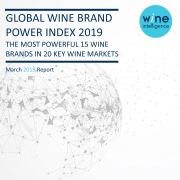For immediate release: 14th March 2019
Building on feedback from over 20,000 wine drinkers in 20 markets – representing the views of 390 million wine drinkers globally – the second year of the study finds that the US, Chile and Australia remain the dominant source countries for powerful wine brands. In addition to five more markets than the inaugural report published in March 2018, this second edition includes tracking from the 2018 index to mark how top brand performance compares with 2019, noting that some of the changes may arise from the expanded market scope of the 2019 Wine Brand Power Index. Ranking differences at an individual country level will be unaffected.
In terms of what has changed, there is a consistent and overall drop in the calculated Global Wine Brand Power Index score itself from 2018 to 2019. This has been driven by one key shift: the ongoing decline in wine brand awareness amongst wine drinkers. This shift is, in part, driven by a process called cognitive off-loading, where we rely increasingly on instant, online resources to retrieve information as and when we require it. This leads to us no longer needing to store and remember as much information in our memories, as a ‘mega-encyclopaedia’ is now available at our fingertips via our smartphones, diluting the need for us to commit less necessary or important facts and pieces of information to our memory. This is reflected in the world of wine, where consumers are aware of fewer wine brands than they were 10 years ago – despite a rising involvement level with the category.
The Global Wine Brand Power Index once again puts Yellow Tail as the most powerful wine brand, followed by Casillero del Diablo. Notable climbers in the index are Jacob’s Creek (up 4 places to #3=) and JP Chenet (up 3 places to #5), the latter brand benefiting from its strong position in Belgium and Netherlands, newcomers to the country scope. Fallers include Woodbridge (down 5 places to #9) and Beringer (down 3 places to #11), both of which have been likely impacted by the expanded country scope that down weights the impact of the US market, where both brands are strongest, as well as cognitive off-loading.
Commenting on the report, CEO Lulie Halstead said: “It’s interesting to see that wine brands, as a whole, have a challenge on their hands to hang onto their spot within consumers’ minds. The high-ranking brands in this list tend to have distinctive imagery, solid and consistent branding and tend to be the ones doing well, or very well, across multiple markets. This last observation also supports other evidence that we observe: despite market and cultural differences, wine drinkers have a strong tendency to value similar things in their wine brands across markets.”
The Global Wine Brand Power Index 2019 report is now available for purchase.
Report details:
Further details about the report can be found here.
Review copies of the report are available to accredited media, subject to standard terms of use. For this, or any questions regarding the press release, please contact Courtney Abernathy.
Requests for purchase should be directed to Emily Carroll.



